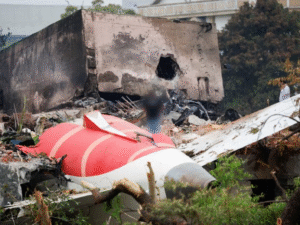
On June 12, 2025, Ahmedabad witnessed a tragedy that shook the entire nation. Air India Flight AI‑171, a routine international journey, turned into a national catastrophe when it crashed just minutes after takeoff, leaving behind loss, questions, and heartbreak. This plane crash in Ahmedabad remains one of the most devastating in India’s history.
The Moment Everything Changed
Air India Flight AI‑171 took off from Sardar Vallabhbhai Patel International Airport, heading toward London Gatwick. But within five minutes, the plane descended rapidly and lost contact with air traffic control. It crashed into the B.J. Medical College campus and nearby hostel buildings, killing nearly everyone on board.
The sky filled with thick smoke. People ran from nearby homes, stunned by what felt like an earthquake. Many feared for their loved ones. This wasn’t just a crash—it was the city’s darkest hour.
- 241 of 242 people on board lost their lives.
- The only survivor was British national Vishwash Kumar Ramesh.
- 28 people on the ground, including students and staff, also died.
A City in Shock
Emergency teams rushed to the site—firefighters, the NDRF, police, and local volunteers. Streets were covered in metal, fire, and pieces of buildings. Rescue workers carried out injured students from hostel ruins. Families gathered outside hospitals and morgues. For many, the wait was long and unbearable.
Prime Minister Modi visited Ahmedabad, expressing grief and promising full support to families and investigators.
The Sole Survivor
Vishwash Kumar Ramesh, the only person to survive, was sitting near an emergency exit. He described feeling the jolt, hearing people scream, and then blacking out. When he awoke, he was surrounded by smoke, heat, and debris—but managed to crawl to safety. He is recovering in hospital with minor injuries and deep emotional scars.
The Investigation Begins
Authorities recovered the plane’s black box, which will be key to understanding what went wrong. Though the Boeing 787‑8 Dreamliner had no fatal crash history before, this disaster has put its safety and maintenance procedures under a microscope.
Investigators are focusing on:
- A possible technical failure during takeoff.
- Delayed or missed maintenance checks.
- Any unusual activity in the flight data or pilot communication.
Boeing, India’s AAIB, the UK’s AAIB, and GE Aerospace are all involved in the probe.
A Growing List of Questions
Many are asking if this tragedy could have been prevented. Reports suggest that the aircraft had minor technical issues in the past and hadn’t completed its latest six-month inspection. These are serious red flags in the aviation industry and could point to systemic failures.
The incident has raised new concerns about:
- Aircraft maintenance accountability.
- Pilot readiness for technical emergencies.
- Oversight from aviation authorities.
The Human Side of the Story
Beyond the technical facts, this is a deeply human tragedy. Among those who died were students, doctors, businesspeople, and entire families heading abroad. Some were traveling for work, some for school, others for medical reasons. The grief has no boundaries.
Memorials and candlelight vigils have been held across Ahmedabad. Flags flew at half-mast. Families from both India and the UK have come together in sorrow.
Support and Relief
The Tata Group, which owns Air India, announced ₹1 crore compensation to the families of each deceased passenger. Counseling centers were set up for the affected. Air India has set up emergency hotlines and promised to fully support every grieving family.
Flights were temporarily suspended at Ahmedabad airport but resumed after a full safety inspection.
A Global Response
Condolences came in from around the world. Leaders from the UK, US, and across Asia expressed sadness and solidarity. Aviation experts everywhere are watching this case closely, as it could have long-term impacts on how planes are maintained and flown.
Why It Matters
This crash is not just a news story. It reminds us of how important airline safety is, and how one small failure can change hundreds of lives. It pushes governments, companies, and international agencies to think harder about what’s really going on behind the scenes in the aviation world.
Final Thoughts
The story of Air India Flight AI‑171 will live on in memory not just because of the lives lost, but because of what it teaches us. That safety is never optional. That the pain of loss deserves answers. And that in moments of darkness, courage, compassion, and truth must lead the way.
This was more than a crash. It was a moment that broke hearts—and hopefully, it will lead to changes that save lives in the future.













